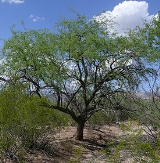
Prosopis velutina
Encyclopedia
Prosopis velutina, commonly known as velvet mesquite, is a small to medium sized perennial tree
. It is a legume adapted to a dry, desert
climate. Though considered to be a noxious weed
in states outside its natural range, it plays a vital role in the ecology of the Sonoran Desert
.
, Mojave
, and Chihuahuan
deserts. It grows at elevations below 4,000 to 5,000 feet in desert grassland
s and near washes
. The main distribution is in central and southern Arizona
and in adjacent Sonora
Mexico
. Near waterways, mesquites can form deciduous woodlands called bosque
s.
s. The youngest branches may be green and photosynthetic
. Young bark is reddish-brown and smooth. As it matures, it becomes a dark, dusty gray or brown and takes on a shredded texture. Yellow thorns up to one inch long appear on the young branches. The leaves
are about 3-6 in (7.5–15 cm) long, fine, and bipinnately compound
. They fold closed at night.
 The taproot
The taproot
sinks deep into the earth, far deeper than the height of the tree, taking advantage of water sources inaccessible to most plants. Roots extend to about 50 ft (15 m), but depths as much as 175 ft (53 m) have been recorded.
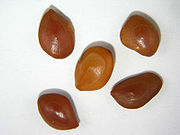
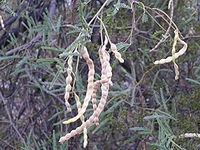 The mesquite is deciduous
The mesquite is deciduous
, losing its leaves in winter and leafs out again in the spring when all danger of frost is past. Because of its deep root
system, it keeps its leaves in the dry months of summer in all but the most severe drought
years. The flower
s are yellow and form in the spring (after the leaves) in dense cylindrical clusters (catkin
s) roughly 4 in (10.2 cm) long. Long seedpods (legumes) form from the flowers. They are bright green and look somewhat like pea pods when young. Mature, dry pods are hard and contain several hard, dry, brown seed
s. The seeds need to be scarified
before they can germinate
. This scarification typically takes place in the digestive tract of animals, who eat the seeds and then disperse
them widely, as the seed takes days to pass through the animal.
ecosystem. Coyote
s, round-tailed ground squirrel
s, collared peccaries
, mule deer
, white-tailed deer
, and jackrabbits
all eat mesquite pods, as do livestock when they are available. Bird
s feed on the flower buds. As a member of the legume family, mesquites fix nitrogen
in the soil
. Mesquites can serve as nurse tree
s to young cacti
, such as the saguaro
. The shade of its branches provides protection for small mammal
s, especially burrowing animals. Native Americans used the seeds for food, grinding them into a flour
. The bark
was used for baskets and fabrics and the wood for firewood
and building. The leaves and gum
were used as medicine
.
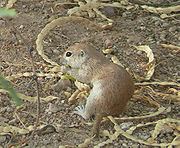 The range of the velvet mesquite has changed because of grazing. Cattle
The range of the velvet mesquite has changed because of grazing. Cattle
not only dispersed
mesquite seeds, but they also overgrazed
the land, resulting in fewer range fires
to control the mesquite population. Mesquites grew more densely and spread into what had been grassland. Consequently, velvet mesquite is considered an invasive species
or noxious weed in several states. On the other hand, mesquite bosque
s cover only a small fraction of the area they covered before human settlement. Agriculture, firewood cutting, housing developments, and the lowering of the water table
have all contributed to the loss of native mesquite stands.
Dried and toasted, the pods are ground into mesquite meal and mesquite flour. Both wonderful for cooking. Naturally sweet, you can reduce or eliminate sugar in some recipes. Both flour and meal make luscious cakes and breads, muffins and pancakes. Mix some wheat
or spelt
flour in with the mesquite since it has no gluten
, and otherwise the cakes are very crumbly.
To make mesquite meal or flour you will need to harvest pods, rinse them, and toast them. Bake whole at 200 degrees F for two to three hours, until they are a toasty tan color. Stir them every so often to prevent burning. Once toasted, grind
pods in a grinder or blender. Process only a handful at a time, for 20 to 30 seconds. Grind for less time and you get a mesquite meal, which can be used instead of corn meal in any recipe. Pour the result into a sifter and collect the flour. If you have a coffee or hand mill, those work well too. If you don't toast them first, you may not be able to grind them.

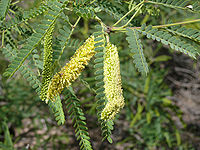
Tree
A tree is a perennial woody plant. It is most often defined as a woody plant that has many secondary branches supported clear of the ground on a single main stem or trunk with clear apical dominance. A minimum height specification at maturity is cited by some authors, varying from 3 m to...
. It is a legume adapted to a dry, desert
Desert
A desert is a landscape or region that receives an extremely low amount of precipitation, less than enough to support growth of most plants. Most deserts have an average annual precipitation of less than...
climate. Though considered to be a noxious weed
Noxious weeds
A noxious weed is an invasive species of a plant that has been designated by country, state or provincial, or national agricultural authorities as one that is injurious to agricultural and/or horticultural crops, natural habitats and/or ecosystems, and/or humans or livestock...
in states outside its natural range, it plays a vital role in the ecology of the Sonoran Desert
Sonoran Desert
The Sonoran Desert is a North American desert which straddles part of the United States-Mexico border and covers large parts of the U.S. states of Arizona and California and the northwest Mexican states of Sonora, Baja California, and Baja California Sur. It is one of the largest and hottest...
.
Distribution
Velvet mesquite is native to the SonoranSonoran Desert
The Sonoran Desert is a North American desert which straddles part of the United States-Mexico border and covers large parts of the U.S. states of Arizona and California and the northwest Mexican states of Sonora, Baja California, and Baja California Sur. It is one of the largest and hottest...
, Mojave
Mojave Desert
The Mojave Desert occupies a significant portion of southeastern California and smaller parts of central California, southern Nevada, southwestern Utah and northwestern Arizona, in the United States...
, and Chihuahuan
Chihuahuan Desert
The Chihuahuan Desert is a desert, and an ecoregion designation, that straddles the U.S.-Mexico border in the central and northern portions of the Mexican Plateau, bordered on the west by the extensive Sierra Madre Occidental range, and overlaying northern portions of the east range, the Sierra...
deserts. It grows at elevations below 4,000 to 5,000 feet in desert grassland
Grassland
Grasslands are areas where the vegetation is dominated by grasses and other herbaceous plants . However, sedge and rush families can also be found. Grasslands occur naturally on all continents except Antarctica...
s and near washes
Arroyo (creek)
An arroyo , a Spanish word translated as brook, and also called a wash is usually a dry creek or stream bed—gulch that temporarily or seasonally fills and flows after sufficient rain. Wadi is a similar term in Africa. In Spain, a rambla has a similar meaning to arroyo.-Types and processes:Arroyos...
. The main distribution is in central and southern Arizona
Arizona
Arizona ; is a state located in the southwestern region of the United States. It is also part of the western United States and the mountain west. The capital and largest city is Phoenix...
and in adjacent Sonora
Sonora
Sonora officially Estado Libre y Soberano de Sonora is one of the 31 states which, with the Federal District, comprise the 32 Federal Entities of Mexico. It is divided into 72 municipalities; the capital city is Hermosillo....
Mexico
Mexico
The United Mexican States , commonly known as Mexico , is a federal constitutional republic in North America. It is bordered on the north by the United States; on the south and west by the Pacific Ocean; on the southeast by Guatemala, Belize, and the Caribbean Sea; and on the east by the Gulf of...
. Near waterways, mesquites can form deciduous woodlands called bosque
Bosque
Bosque is the name for areas of gallery forest found along the riparian flood plains of stream and river banks in the southwestern United States...
s.
Description
Velvet mesquite can grow to 30–50 ft (9–15 m) tall or more. It grows larger in areas with ample water, smaller in open, dry grasslandGrassland
Grasslands are areas where the vegetation is dominated by grasses and other herbaceous plants . However, sedge and rush families can also be found. Grasslands occur naturally on all continents except Antarctica...
s. The youngest branches may be green and photosynthetic
Photosynthesis
Photosynthesis is a chemical process that converts carbon dioxide into organic compounds, especially sugars, using the energy from sunlight. Photosynthesis occurs in plants, algae, and many species of bacteria, but not in archaea. Photosynthetic organisms are called photoautotrophs, since they can...
. Young bark is reddish-brown and smooth. As it matures, it becomes a dark, dusty gray or brown and takes on a shredded texture. Yellow thorns up to one inch long appear on the young branches. The leaves
Leaf
A leaf is an organ of a vascular plant, as defined in botanical terms, and in particular in plant morphology. Foliage is a mass noun that refers to leaves as a feature of plants....
are about 3-6 in (7.5–15 cm) long, fine, and bipinnately compound
Pinnate
Pinnate is a term used to describe feather-like or multi-divided features arising from both sides of a common axis in plant or animal structures, and comes from the Latin word pinna meaning "feather", "wing", or "fin". A similar term is pectinate, which refers to a comb-like arrangement of parts...
. They fold closed at night.

Taproot
A taproot is an enlarged, somewhat straight to tapering plant root that grows vertically downward. It forms a center from which other roots sprout laterally.Plants with taproots are difficult to transplant...
sinks deep into the earth, far deeper than the height of the tree, taking advantage of water sources inaccessible to most plants. Roots extend to about 50 ft (15 m), but depths as much as 175 ft (53 m) have been recorded.


Deciduous
Deciduous means "falling off at maturity" or "tending to fall off", and is typically used in reference to trees or shrubs that lose their leaves seasonally, and to the shedding of other plant structures such as petals after flowering or fruit when ripe...
, losing its leaves in winter and leafs out again in the spring when all danger of frost is past. Because of its deep root
Root
In vascular plants, the root is the organ of a plant that typically lies below the surface of the soil. This is not always the case, however, since a root can also be aerial or aerating . Furthermore, a stem normally occurring below ground is not exceptional either...
system, it keeps its leaves in the dry months of summer in all but the most severe drought
Drought
A drought is an extended period of months or years when a region notes a deficiency in its water supply. Generally, this occurs when a region receives consistently below average precipitation. It can have a substantial impact on the ecosystem and agriculture of the affected region...
years. The flower
Flower
A flower, sometimes known as a bloom or blossom, is the reproductive structure found in flowering plants . The biological function of a flower is to effect reproduction, usually by providing a mechanism for the union of sperm with eggs...
s are yellow and form in the spring (after the leaves) in dense cylindrical clusters (catkin
Catkin
A catkin or ament is a slim, cylindrical flower cluster, with inconspicuous or no petals, usually wind-pollinated but sometimes insect pollinated . They contain many, usually unisexual flowers, arranged closely along a central stem which is often drooping...
s) roughly 4 in (10.2 cm) long. Long seedpods (legumes) form from the flowers. They are bright green and look somewhat like pea pods when young. Mature, dry pods are hard and contain several hard, dry, brown seed
Seed
A seed is a small embryonic plant enclosed in a covering called the seed coat, usually with some stored food. It is the product of the ripened ovule of gymnosperm and angiosperm plants which occurs after fertilization and some growth within the mother plant...
s. The seeds need to be scarified
Scarification (botany)
Scarification in botany involves cutting the seed coat using abrasion, thermal stress, or chemicals to encourage germination.-In botany:Scarification is a natural process important for germination of many species' seeds. This process involves the breaching of the natural seed coating by mechanical,...
before they can germinate
Germination
Germination is the process in which a plant or fungus emerges from a seed or spore, respectively, and begins growth. The most common example of germination is the sprouting of a seedling from a seed of an angiosperm or gymnosperm. However the growth of a sporeling from a spore, for example the...
. This scarification typically takes place in the digestive tract of animals, who eat the seeds and then disperse
Seed dispersal
Seed dispersal is the movement or transport of seeds away from the parent plant. Plants have limited mobility and consequently rely upon a variety of dispersal vectors to transport their propagules, including both abiotic and biotic vectors. Seeds can be dispersed away from the parent plant...
them widely, as the seed takes days to pass through the animal.
Ecology
The mesquite contributes greatly to the desertDesert
A desert is a landscape or region that receives an extremely low amount of precipitation, less than enough to support growth of most plants. Most deserts have an average annual precipitation of less than...
ecosystem. Coyote
Coyote
The coyote , also known as the American jackal or the prairie wolf, is a species of canine found throughout North and Central America, ranging from Panama in the south, north through Mexico, the United States and Canada...
s, round-tailed ground squirrel
Round-tailed Ground Squirrel
The round-tailed ground squirrel , known as "Ardillón cola redonda" in Spanish, live in the desert of the Southwestern United States and adjacent Mexico. They are called "ground squirrels" because they burrow in loose soil, often under mesquite trees and creosote bushes.-Characteristics:Most...
s, collared peccaries
Collared Peccary
The collared peccary is a species of mammal in the family Tayassuidae that is found in North, Central, and South America. They are commonly referred to as javelina, saíno or báquiro, although these terms are also used to describe other species in the family...
, mule deer
Mule Deer
The mule deer is a deer indigenous to western North America. The Mule Deer gets its name from its large mule-like ears. There are believed to be several subspecies, including the black-tailed deer...
, white-tailed deer
White-tailed Deer
The white-tailed deer , also known as the Virginia deer or simply as the whitetail, is a medium-sized deer native to the United States , Canada, Mexico, Central America, and South America as far south as Peru...
, and jackrabbits
Hare
Hares and jackrabbits are leporids belonging to the genus Lepus. Hares less than one year old are called leverets. Four species commonly known as types of hare are classified outside of Lepus: the hispid hare , and three species known as red rock hares .Hares are very fast-moving...
all eat mesquite pods, as do livestock when they are available. Bird
Bird
Birds are feathered, winged, bipedal, endothermic , egg-laying, vertebrate animals. Around 10,000 living species and 188 families makes them the most speciose class of tetrapod vertebrates. They inhabit ecosystems across the globe, from the Arctic to the Antarctic. Extant birds range in size from...
s feed on the flower buds. As a member of the legume family, mesquites fix nitrogen
Nitrogen fixation
Nitrogen fixation is the natural process, either biological or abiotic, by which nitrogen in the atmosphere is converted into ammonia . This process is essential for life because fixed nitrogen is required to biosynthesize the basic building blocks of life, e.g., nucleotides for DNA and RNA and...
in the soil
Soil
Soil is a natural body consisting of layers of mineral constituents of variable thicknesses, which differ from the parent materials in their morphological, physical, chemical, and mineralogical characteristics...
. Mesquites can serve as nurse tree
Nurse tree
A nurse tree is a larger, faster-growing tree that shelters a smaller, slower-growing tree or plant. The nurse tree can provide shade, shelter from wind, or protection from animals who would feed on the smaller plant....
s to young cacti
Cactus
A cactus is a member of the plant family Cactaceae. Their distinctive appearance is a result of adaptations to conserve water in dry and/or hot environments. In most species, the stem has evolved to become photosynthetic and succulent, while the leaves have evolved into spines...
, such as the saguaro
Saguaro
The saguaro is a large, tree-sized cactus species in the monotypic genus Carnegiea. It is native to the Sonoran Desert in the U.S. state of Arizona, the Mexican state of Sonora, a small part of Baja California in the San Felipe Desert and an extremely small area of California, U.S...
. The shade of its branches provides protection for small mammal
Mammal
Mammals are members of a class of air-breathing vertebrate animals characterised by the possession of endothermy, hair, three middle ear bones, and mammary glands functional in mothers with young...
s, especially burrowing animals. Native Americans used the seeds for food, grinding them into a flour
Flour
Flour is a powder which is made by grinding cereal grains, other seeds or roots . It is the main ingredient of bread, which is a staple food for many cultures, making the availability of adequate supplies of flour a major economic and political issue at various times throughout history...
. The bark
Bark
Bark is the outermost layers of stems and roots of woody plants. Plants with bark include trees, woody vines and shrubs. Bark refers to all the tissues outside of the vascular cambium and is a nontechnical term. It overlays the wood and consists of the inner bark and the outer bark. The inner...
was used for baskets and fabrics and the wood for firewood
Firewood
Firewood is any wood-like material that is gathered and used for fuel. Generally, firewood is not highly processed and is in some sort of recognizable log or branch form....
and building. The leaves and gum
Natural gum
Natural gums are polysaccharides of natural origin, capable of causing a large viscosity increase in solution, even at small concentrations. In the food industry they are used as thickening agents, gelling agents, emulsifying agents, and stabilizers...
were used as medicine
Herbalism
Herbalism is a traditional medicinal or folk medicine practice based on the use of plants and plant extracts. Herbalism is also known as botanical medicine, medical herbalism, herbal medicine, herbology, herblore, and phytotherapy...
.

Cattle
Cattle are the most common type of large domesticated ungulates. They are a prominent modern member of the subfamily Bovinae, are the most widespread species of the genus Bos, and are most commonly classified collectively as Bos primigenius...
not only dispersed
Seed dispersal
Seed dispersal is the movement or transport of seeds away from the parent plant. Plants have limited mobility and consequently rely upon a variety of dispersal vectors to transport their propagules, including both abiotic and biotic vectors. Seeds can be dispersed away from the parent plant...
mesquite seeds, but they also overgrazed
Overgrazing
Overgrazing occurs when plants are exposed to intensive grazing for extended periods of time, or without sufficient recovery periods. It can be caused by either livestock in poorly managed agricultural applications, or by overpopulations of native or non-native wild animals.Overgrazing reduces the...
the land, resulting in fewer range fires
Wildfire
A wildfire is any uncontrolled fire in combustible vegetation that occurs in the countryside or a wilderness area. Other names such as brush fire, bushfire, forest fire, desert fire, grass fire, hill fire, squirrel fire, vegetation fire, veldfire, and wilkjjofire may be used to describe the same...
to control the mesquite population. Mesquites grew more densely and spread into what had been grassland. Consequently, velvet mesquite is considered an invasive species
Invasive species
"Invasive species", or invasive exotics, is a nomenclature term and categorization phrase used for flora and fauna, and for specific restoration-preservation processes in native habitats, with several definitions....
or noxious weed in several states. On the other hand, mesquite bosque
Bosque
Bosque is the name for areas of gallery forest found along the riparian flood plains of stream and river banks in the southwestern United States...
s cover only a small fraction of the area they covered before human settlement. Agriculture, firewood cutting, housing developments, and the lowering of the water table
Water table
The water table is the level at which the submarine pressure is far from atmospheric pressure. It may be conveniently visualized as the 'surface' of the subsurface materials that are saturated with groundwater in a given vicinity. However, saturated conditions may extend above the water table as...
have all contributed to the loss of native mesquite stands.
Uses
- Velvet mesquite is a common choice for residential and commercial xeriscapingXeriscapingXeriscaping and xerogardening refers to landscaping and gardening in ways that reduce or eliminate the need for supplemental water from irrigation...
in TucsonTucson, ArizonaTucson is a city in and the county seat of Pima County, Arizona, United States. The city is located 118 miles southeast of Phoenix and 60 miles north of the U.S.-Mexico border. The 2010 United States Census puts the city's population at 520,116 with a metropolitan area population at 1,020,200...
and PhoenixPhoenix, ArizonaPhoenix is the capital, and largest city, of the U.S. state of Arizona, as well as the sixth most populated city in the United States. Phoenix is home to 1,445,632 people according to the official 2010 U.S. Census Bureau data...
, cities which are inside its natural range. An established mesquite tree needs little or no watering, and is an attractive ornamental plantOrnamental plantOrnamental plants are plants that are grown for decorative purposes in gardens and landscape design projects, as house plants, for cut flowers and specimen display...
.
- Medicinal uses: Sore throats were treated with a hot tea made from a blend of the clear sap plus inner red barkBarkBark is the outermost layers of stems and roots of woody plants. Plants with bark include trees, woody vines and shrubs. Bark refers to all the tissues outside of the vascular cambium and is a nontechnical term. It overlays the wood and consists of the inner bark and the outer bark. The inner...
. Stomach aches were treated with a tea made from the fresh leaves. Toothache was treated by chewing the soft inner bark of the root. For flagging appetite, a tea made from the dried leaves was taken before meals.
- Cosmetic uses: Most important to a select number of folks was mesquite's use against hair loss. This treatment was used by men only, and consisted of the black sap that oozes from mesquite wounds (not the clear sap) mixed with other secret herbs and applied to the scalp. Special mesquite herbal soap for "macho" hair is still available in parts of Mexico.
- Bark was used for baskets and fabrics.
- Wood is important for firewood and for flavor when grilling meat.
Food
Mesquite pods are an important source of food for humans as well as native wildlife. Pods are considered a slow release food due to galactomannin gums which have been found to lower glycemic responses. Their glycemic index is 25 percent, compared to 60 for sweet corn, and 100 for white sugar.Dried and toasted, the pods are ground into mesquite meal and mesquite flour. Both wonderful for cooking. Naturally sweet, you can reduce or eliminate sugar in some recipes. Both flour and meal make luscious cakes and breads, muffins and pancakes. Mix some wheat
Wheat
Wheat is a cereal grain, originally from the Levant region of the Near East, but now cultivated worldwide. In 2007 world production of wheat was 607 million tons, making it the third most-produced cereal after maize and rice...
or spelt
Spelt
Spelt is a hexaploid species of wheat. Spelt was an important staple in parts of Europe from the Bronze Age to medieval times; it now survives as a relict crop in Central Europe and northern Spain and has found a new market as a health food. Spelt is sometimes considered a subspecies of the...
flour in with the mesquite since it has no gluten
Gluten
Gluten is a protein composite found in foods processed from wheat and related grain species, including barley and rye...
, and otherwise the cakes are very crumbly.
To make mesquite meal or flour you will need to harvest pods, rinse them, and toast them. Bake whole at 200 degrees F for two to three hours, until they are a toasty tan color. Stir them every so often to prevent burning. Once toasted, grind
Grind
The grind of a blade refers to the shape of the cross-section of the blade. It is distinct from the type of blade , though different tools and blades may have lent their name to a particular grind.Grinding involves removing significant portions of metal from the blade and is thus distinct from...
pods in a grinder or blender. Process only a handful at a time, for 20 to 30 seconds. Grind for less time and you get a mesquite meal, which can be used instead of corn meal in any recipe. Pour the result into a sifter and collect the flour. If you have a coffee or hand mill, those work well too. If you don't toast them first, you may not be able to grind them.



